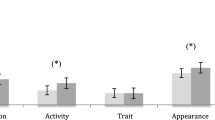Abstract
The effects of several nonverbal cues on perceptions of male and female stimulus persons' sexuality were examined. Based on the findings of Abbey (“Sex Differences in Attributions for Friendly Behavior: Do Males Misperceive Females' Friendliness?” Journal of Personality and Social Psychology, 1982, 42, 830–838) and other investigators, we hypothesized that in general males would attribute more sexuality to both male and female targets than would females. Furthermore, we hypothesized that males' and females' perceptions of sexual intent would be most divergent in situations in which the nonverbal cues were most ambiguous (e.g., causal touch, moderate interpersonal distance). To test this hypothesis, the effects of three nonverbalcues were examined: interpersonal distance, eye contact, and touch. Males rated female targets as more seductive, sexy, and promiscuous, and expressed more sexual attraction to the opposite-sexed target, than females did for both ambiguous and nonambiguous nonverbal cues. Males' ratings of the male targets' sexuality were higher than females' ratings in two of the three studies. Also, across the three studies both female and male subjects rated the female target higher than the male target on the sexual traits. The implications of these findings for future research are discussed.
Similar content being viewed by others
References
Abbey, A. Sex differences in attributions for friendly behavior: Do males misperceive females' friendliness? Journal of Personality and Social Psychology, 1982, 42, 830–838.
Abbey, A., Cozzarelli, C., McLaughlin, K., & Harnish, R. J. The effects of clothing and dyad sex composition on perceptions of sexual intent: Do women and men evaluate these cues differently? Journal of Applied Social Psychology, in press.
Aiello, J. R., & Cooper, R. E. Use of personal space as a function of social affect. Paper presented at the 80th Annual meeting of the American Psychological Association, Washington, D.C., August 1972.
Byrne, D., Ervin, C. R., & Lamberth, J. Continuity between the experimental study of attraction and real-life computer dating. Journal of Personality and Social Psychology, 1970, 16, 157–165.
Evans, G. W., & Howard, R. B. Personal space. Psychological Bulletin, 1973, 80, 334–344.
Exline, R. V., & Winters, L. C. Affective relations and mutual glance in dyads. In S. Tomkins & C. Izard (Eds.), Affect, cognition, and personality. New York: Springer, 1965.
Gifford, R. Projected interpersonal distance and orientation choices: Personality, sex, and social situation. Social Psychology Quarterly, 1982, 45, 145–152.
Gross, A. E. The male role and heterosexual behavior. Journal of Social Issues, 1978, 34, 87–107.
Guardo, C. J. Personal space in children. Child Development, 1969, 40, 143–151.
Hall, E. T. The silent language. Garden City, N.Y.: Doubleday, 1959.
Hayduk, L. A. Personal space: An evaluative and orienting overview. Psychological Bulletin, 1978, 85. 117–134.
Henley, N. M. Status and sex: Some touching observations. Bulletin of the Psychonomic Society, 1973, 2, 91–93.
Henley, N. M. Body politics: Power, sex, and nonverbal communication. New York: Prentice Hall, 1977.
Heslin, R., & Alper, T. Touch: A bounding gesture. In J. M. Wiemann & R. P. Harrison (Ed.), Nonverbal communication (Vol. 11, Sage Annual Reviews of Communications Research). Beverly Hills, Calif.: Sage, 1982.
Heslin, R., & Boss, D. Nonverbal intimacy in airport arrival and departure. Personality and Social Psychology Bulletin, 1980, 6, 248–252.
Heslin, R., & Patterson, M. L. Nonverbal behavior and social psychology. New York: Plenum Press, 1982.
Kanin, E. J. Selected dyadic aspects of male sex aggression. Journal of Sex Research, 1969, 5, 12–28.
Kelly, F. D. Communicational significance of therapist promexic cues. Journal of Consulting and Clinical Psychology, 1972, 39, 345.
Kiesler, C., & Goldberg, G. Multi-dimensional approach to the experimental study of interpersonal attraction: Effect of a blunder on the attractiveness of a competent other. Psychological Reports, 1968, 22, 693–705.
Kleinke, C. L. Interpersonal attraction as it relates to gaze and distance between people. Representative Research in Social Psychology, 1972, 3, 105–120.
Kleinke, C. L., Meeker, F. B., & LaFong, C. L. Effects of gaze, touch, and use of name in evaluation of “engaged” couples. Journal of Research in Personality, 1974, 7, 368–373.
Major, B. Gender patterns in touching behavior. In C. Mayo & N. M. Henley (Eds.), Gender and nonverbal behavior. New York: Springer-Verlag, 1981.
Major, B., & Heslin, R. Perceptions of cross-sex and same-sex nonreciprocal touch: It is better to give than to receive. Journal of Nonverbal Behavior, 1982, 6, 148–162.
Mehrabian, A. Relationship of attitude to seated posture, orientation, and distance. Journal of Personality and Social Psychology, 1968, 10, 26–30.
Mehrabian, A. Significance of posture and position in the communication of attitude and status relationships. Psychological Bulletin, 1969, 71(5), 359–372.
Mehrabian, A. Nonverbal communication. Chicago, Ill.: Aldine-Atherton, 1972.
Rubin, Z. Measurement of romantic love. Journal of Personality and Social Psychology, 1970, 16(2), 265–273.
Rytting, M. B. Sex or intimacy: Male and female versions of heterosexual relationships. Paper presented at the Annual meeting of the Midwestern Psychological Association, Chicago, Ill., May 1976.
Scherer, S. E., & Schiff, M. R. Perceived intimacy, physical distance, and eye contact. Perceptual and Motor Skills, 1973, 36, 835–841.
Stass, J., & Willis, F. N. Eye contact, pupil dilation, and personal preference. Psychonomic Science, 1967, 7, 375–376.
Stier, D. S., & Hall, J. A. Gender differences in touch: An empirical and theoretical review. Journal of Personality and Social Psychology, 1984, 47, 440–459.
Umiker-Sebeok, J. The seven ages of women: A review from American magazine advertisements. In C. Mayo & N. M. Henley (Eds.), Gender and nonverbal behavior. New York: Springer-Verlag, 1981.
Zellman, G. L., & Goodchilds, J. D. Becoming sexual in adolescence. In E. A. Allgeier & N. B. McCormick (Eds.), Changing boundaries: Gender roles and sexual behavior. Palo Alto, Calif.: Mayfield, 1983.
Author information
Authors and Affiliations
Additional information
We would like to thank Chuck Goebel, Richard Harnish, Sue Strong, Esther Strause, Ellen Trumbo, and Nancy Weishew for their assistance in conducting this research.
Rights and permissions
About this article
Cite this article
Abbey, A., Melby, C. The effects of nonverbal cues on gender differences in perceptions of sexual intent. Sex Roles 15, 283–298 (1986). https://doi.org/10.1007/BF00288318
Issue Date:
DOI: https://doi.org/10.1007/BF00288318



